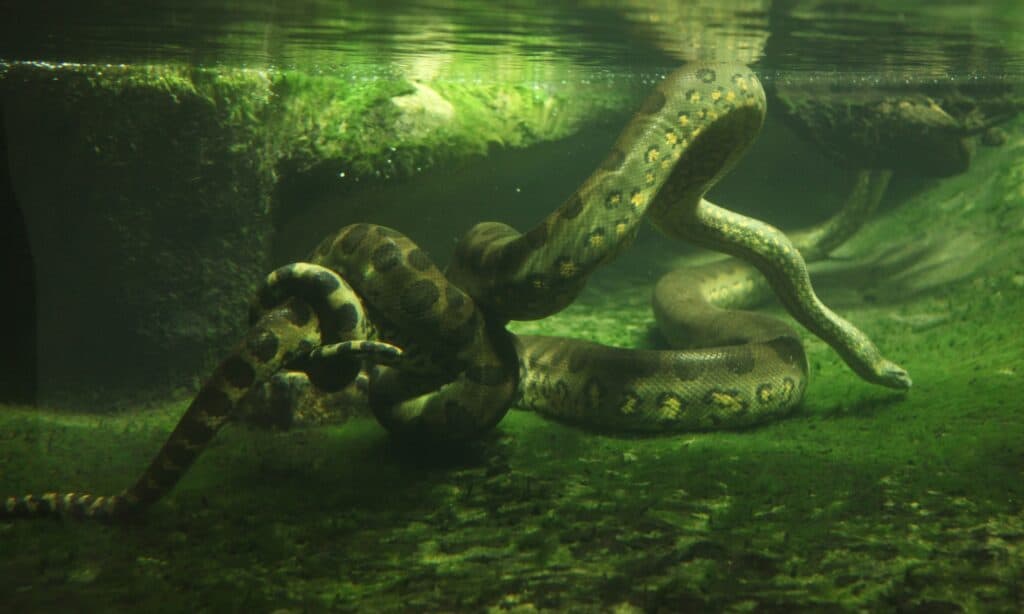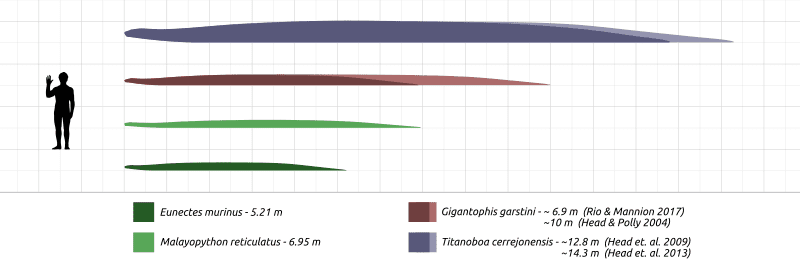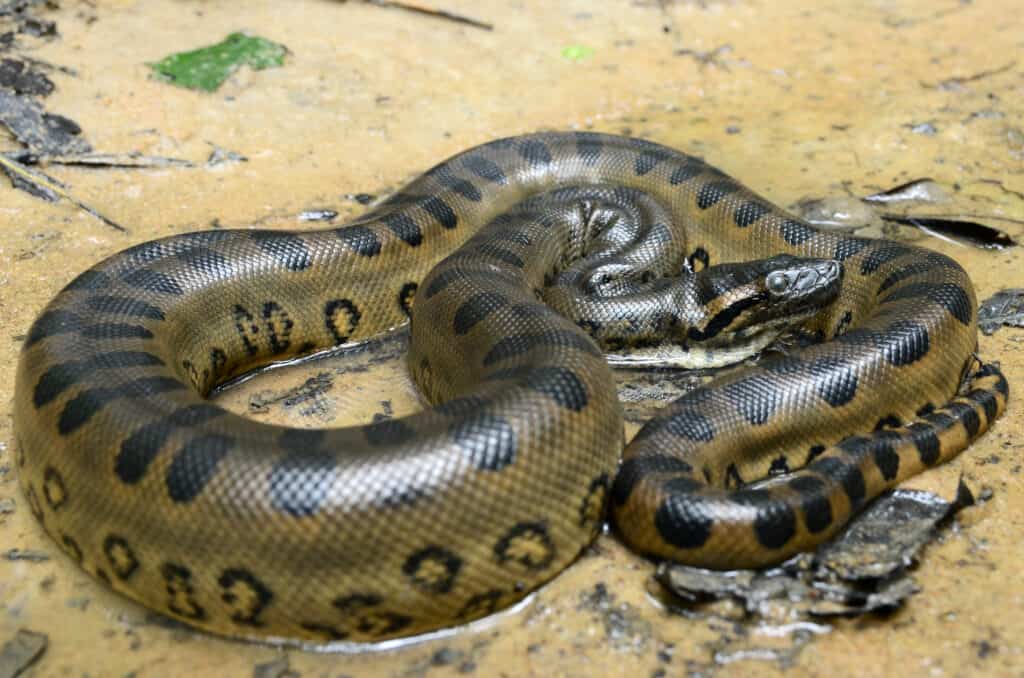
Green anacondas are the heaviest snake species in the world, out of the thousands on Earth. Snakes have inhabited the world for millions of years and first appeared in the Cretaceous period.
Throughout Earth’s history, there have been a variety of different snakes, and even today, there are more than 3,000 different species today. Animals like the Barbados thread snake struggle to weigh more than an ounce, but in this article, you’ll discover 3 massive snakes larger than an anaconda.
Green anacondas are one of the largest snakes you can find today. Fossil evidence found across the globe lets humans know the snakes that lived millions of years before us, and how large ancient snakes were able to get.
The Size Of A Green Anaconda

Anacondas are the largest snakes alive.
©Vladimir Wrangel/Shutterstock.com
Before looking at some of the largest snakes in history, how large can an Anaconda get? Green anacondas have an average length of 20 feet, with the largest getting up to 29 feet long. On average, this snake usually will weigh between 65 to 160 lbs, with some getting up to 550 lbs large.
These mighty serpents put all that mass to use. Green anacondas, like all constrictors, terminate their prey by wrapping their bodies around them and causing suffocation. With their long, muscular bodies, these slithery hunters are able to capture and crush the small mammals and reptiles that make up their diet.
The largest of this species ever recorded weighed 880 lbs (399.1 kgs) and was found in Brazil on a construction site. This snake is able to get extremely large, but attacks on them are rare. Throughout history, large snakes have ruled the habitats they lived in and are dominant predators.
What Are The Largest Snakes In History?
Here are three of the largest snakes alive that are much larger than the anaconda alive today. Fossil evidence left behind by these animals is used to estimate their size. Finding the correct size is difficult, but scientists can estimate an animal’s size even with little fossils to use.
1. Gigantophis

Gigantophis was the only member of its species.
©By Gamma 124 – Own work, CC BY-SA 4.0, https://commons.wikimedia.org/w/index.php?curid=68655718 – License
The discovery of the Gigantophis genus fossils was published in 1901; which was a large snake species that lived around 40 million years ago. This giant was discovered in ancient Egypt, with vertebrae and rib fossils of the animal seen. The size of this snake is estimated to be between 22 to 35 feet long.
Before 2009, Gigantohpis was considered the largest snake ever to exist. Alive during the Eocene epoch of the Paleogene Period, this snake is believed to live in regions that are Africa and the Middle East today. With their large size, Gigantophis constricted prey and would have likely eaten crocodiles and other reptiles.
2. Palaeophis Colossaeus

The largest sea snake to have existed could eat whale calves.
©Nobu Tamura (http://spinops.blogspot.ca/) / Creative Commons – License
Palaeophis colossaeus is the largest species of ancient sea snake that lived on Earth. This species was estimated to grow between 26.2 to 40 feet (9 to 12.3 meters) long and lived during the middle Eocene period. This snake was aquatic and is the largest sea snake to ever exist. Palaeophis colossaeus is known due to a single vertebra, which was used to estimate its size. Studies suggest this genus of sea snakes grew fast and had a quicker metabolic rate when compared with modern snakes.
3. Titanoboa

Titanoboa grew up to 42 feet long!
©Michael Rosskothen/Shutterstock.com
The titanoboa is an extinct snake, with a massive size much larger than the anacondas of today. Discovered in 2009, it is estimated this species was able to grow to 42 feet in length and weighed 2,755 lbs (1.25 metric tons). Northern Columbia is where this species was discovered, in rocks dated around 58 million years old.
In total, around 30 different specimens of titanoboa were found in Columbia, with vertebrae, skulls, and other useful bones used to learn about this giant. This snake went extinct around 65 million years ago and lived during the Paleocene Epoch.
This massive snake was much longer than the green anaconda and also weighed more than 5 times than them on average. Due to its size, it is believed this snake spends most of its life in rivers and tropical habitats. It is believed to eat mostly fish and was able to prey on any animal it came across.
Are There Any Snakes Larger Than An Anaconda Today?

The reticulated python is one of the snakes very popular with expert reptile keepers.
©Opayaza12/Shutterstock.com
Along with the green anaconda, the reticulated python also holds the title of the largest snake in the world today. The reticulated python is a much lighter species than the green anaconda, and on average, weighs between 66 to 350 lbs. Where reticulated pythons beat the green anaconda is its length, as they are, on average, longer.
Reticulated pythons on average are between 10 to 20 feet. The largest reticulated python ever held in captivity was named Medusa and was kept in the US. Medusa grew to be 25 feet long and weighed 350 lbs. While reticulated pythons are not as heavy, they tend to be longer than the green anaconda.
Both species of snakes are large, but they are much smaller than the giants that roamed the earth millions of years ago.
Anaconda vs Reticulated Python: Which Is More Dangerous To Humans?
The reticulated python is very threatening to humans although attacks are rare. If defending itself or waiting to attack, this massive snake will first bite its prey before wrapping it with its body. Within a few minutes, the human would die of suffocation and lack of blood flow to the brain before slowly being swallowed. The python’s stomach acid would then break down the body through digestion within an hour. Yikes!
The anaconda, however, is not seen as much of a threat to humans. If threatened, they can be aggressive and even kill humans since killing large prey is no problem for them. This nonvenomous snake uses its strong, muscular body to coil around its victim just like the reticulated python. The anaconda is much more aquatic than pythons, so their prey tends to be found in or near water.
Which is more dangerous to humans? The reticulated python is more of a threat to humans because it is faster and more aggressive.
Where Do Green Anacondas Live?

The green anaconda is a native species of large swaths of South America and an invasive species in the state of Florida.
©Patrick K. Campbell/Shutterstock.com
As green anacondas are the largest living snakes on earth, you may have the desire to glimpse one in the wild (albeit from a safe distance). Green anacondas are native to South America, inhabiting Brazil, Colombia, Venezuela, Ecuador, Peru, Bolivia, Guyana, Paraguay, French Guiana, and Trinidad. They are most commonly found in the Orinoco basin of Columbia, the Amazon River basin of Brazil, and the flooded Llanos grasslands in Venezuela.
The green anaconda is also an invasive species in the Everglades in Florida. How this came about is up for debate. However, experts believe that exotic pet owners could have released them into the wild or lost them over time, or green anacondas may have escaped from zoos, pet owners, or animal sanctuaries during Hurricane Andrew in 1992.
Summary of 3 Massive Snakes Larger Than an Anaconda
| Snake Name | Size | |
|---|---|---|
| 1 | Gigantophis | 22 to 35 ft long/1,000 lbs (1/2 ton) heavy |
| 2 | Palaeophis Colossaeus | 26.2 to 40 feet (9 to 12.3 meters) long |
| 3 | Titanboa | 42 ft long/2,755 lbs (1.25 metric tons) heavy |
The photo featured at the top of this post is © Patrick K. Campbell/Shutterstock.com
Discover the "Monster" Snake 5X Bigger than an Anaconda
Every day A-Z Animals sends out some of the most incredible facts in the world from our free newsletter. Want to discover the 10 most beautiful snakes in the world, a "snake island" where you're never more than 3 feet from danger, or a "monster" snake 5X larger than an anaconda? Then sign up right now and you'll start receiving our daily newsletter absolutely free.
Thank you for reading! Have some feedback for us? Contact the AZ Animals editorial team.






